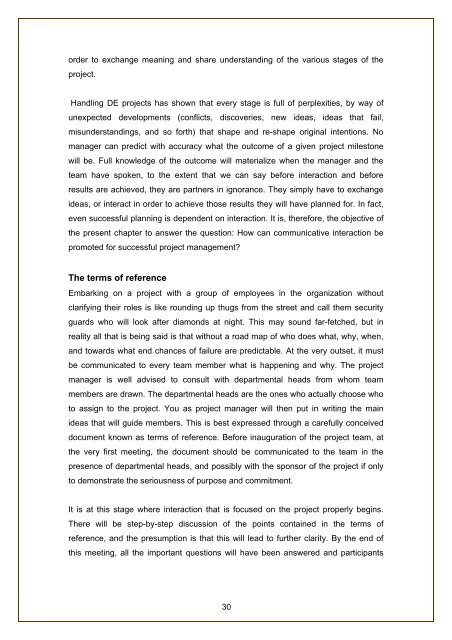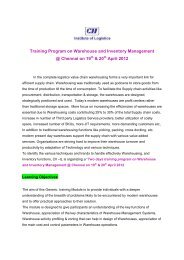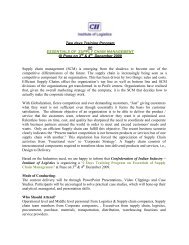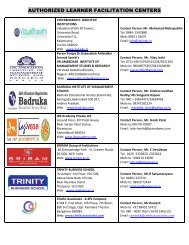successful project management - Commonwealth of Learning
successful project management - Commonwealth of Learning
successful project management - Commonwealth of Learning
Create successful ePaper yourself
Turn your PDF publications into a flip-book with our unique Google optimized e-Paper software.
order to exchange meaning and share understanding <strong>of</strong> the various stages <strong>of</strong> the<br />
<strong>project</strong>.<br />
Handling DE <strong>project</strong>s has shown that every stage is full <strong>of</strong> perplexities, by way <strong>of</strong><br />
unexpected developments (conflicts, discoveries, new ideas, ideas that fail,<br />
misunderstandings, and so forth) that shape and re-shape original intentions. No<br />
manager can predict with accuracy what the outcome <strong>of</strong> a given <strong>project</strong> milestone<br />
will be. Full knowledge <strong>of</strong> the outcome will materialize when the manager and the<br />
team have spoken, to the extent that we can say before interaction and before<br />
results are achieved, they are partners in ignorance. They simply have to exchange<br />
ideas, or interact in order to achieve those results they will have planned for. In fact,<br />
even <strong>successful</strong> planning is dependent on interaction. It is, therefore, the objective <strong>of</strong><br />
the present chapter to answer the question: How can communicative interaction be<br />
promoted for <strong>successful</strong> <strong>project</strong> <strong>management</strong>?<br />
The terms <strong>of</strong> reference<br />
Embarking on a <strong>project</strong> with a group <strong>of</strong> employees in the organization without<br />
clarifying their roles is like rounding up thugs from the street and call them security<br />
guards who will look after diamonds at night. This may sound far-fetched, but in<br />
reality all that is being said is that without a road map <strong>of</strong> who does what, why, when,<br />
and towards what end chances <strong>of</strong> failure are predictable. At the very outset, it must<br />
be communicated to every team member what is happening and why. The <strong>project</strong><br />
manager is well advised to consult with departmental heads from whom team<br />
members are drawn. The departmental heads are the ones who actually choose who<br />
to assign to the <strong>project</strong>. You as <strong>project</strong> manager will then put in writing the main<br />
ideas that will guide members. This is best expressed through a carefully conceived<br />
document known as terms <strong>of</strong> reference. Before inauguration <strong>of</strong> the <strong>project</strong> team, at<br />
the very first meeting, the document should be communicated to the team in the<br />
presence <strong>of</strong> departmental heads, and possibly with the sponsor <strong>of</strong> the <strong>project</strong> if only<br />
to demonstrate the seriousness <strong>of</strong> purpose and commitment.<br />
It is at this stage where interaction that is focused on the <strong>project</strong> properly begins.<br />
There will be step-by-step discussion <strong>of</strong> the points contained in the terms <strong>of</strong><br />
reference, and the presumption is that this will lead to further clarity. By the end <strong>of</strong><br />
this meeting, all the important questions will have been answered and participants<br />
30
















